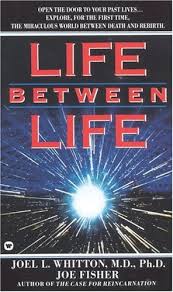 Reviewed by Valerie A. Winn, R.N., M.F.C.C.
Reviewed by Valerie A. Winn, R.N., M.F.C.C.
In JRT Issue 5, Spring 1988
This book is not more fascinating than its two authors and the history of their relationship. Joel Whitton immersed himself in medical training at the University of Toronto while at the same time experimenting with hypnosis. Eventually he ventured into the investigation of past lives, approaching with the objective caution of a trained scientist. Meanwhile, his professional expertise led to his appointment as Chief Psychiatrist in the Toronto School System. It was to protect this position and the research funding for investigating an array of his career interests, among them the study of brain waves in children with learning disabilities, that led him to refuse Joe Fisher’s request in 1982 for material for his book The Case for Reincarnation.
Several years later, to Joe Fisher’s surprise, Dr. Whitton proposed collaboration on a book on interim experiences. Swallowing his feeling of rebuff from the earlier experience, Fisher enthusiastically took up the writing of the book, which is based on in-depth reporting of Dr. Whitton’s research and experiences with patients while they are regressed to the space between lives. Both authors feel that the interlife is educational, therapeutically valuable, and a source of enlightenment.
The interlife period, which follows death and precedes birth and is called the “bardo” in the Tibetan Book of the Dead, describes the human entity in disembodied residence between incarnations. The authors define the bardo as the particular altered state of consciousness that characterizes the awareness from one life to the next, and they provide a rich historical and precedental background for this concept. Dr. Whitton’s original research had been concerned with past lives and this had led accidentally into his search regarding the nature and dimensions of this bardo. In order to explore this area he began to ask the question, “What happens to us between earthly incarnations?”
The first segment of the book is a description of the bardo, including the review period, where the primary focus is on the acquisition of knowledge to prepare the soul for the next incarnation. The authors state that the very nature of the bardo requires each discarnate experience to be flanked by earthly sojourns. In this planning state those souls most committed to their evolutionary progress often lay out plans for several future lifetimes. Dr. Whitton’s clients affirm the existence of a Board of Judgment, usually three older beings whose function it is to initiate discussions of critical episodes in the last life, to offer retrospective counseling, and to instill reassurance that each experience promotes personal development.
The second segment of the book gives several case presentations, with the intent of relating the scientific exploration of the interlife to its therapeutic application. The case presentations are excellent examples of past-life therapy and include appropriate bardo experiences. These latter are more condensed than the past-life experiences, in part because of the difficulty that subjects normally experience in finding adequate vocabulary to describe them.
The final third of the book continues with the case presentations and brings in more information about the client’s exploration of the bardo, the relevancy of this information to current physical and psychological blockages, and their correlation. The last two chapters provide a guide to self-exploration of the interlife and the meaning of that interim period. There is a verbatim visualization process for those who would like to explore an interlife or past life. A bibliography is included.
